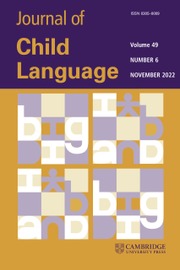1. Introduction
Language development is a significant predictor of later literacy skills, academic achievement, executive functions, and emotion regulation, with language delays having cascading effects into early adulthood (Bornstein et al., Reference Bornstein, Hahn and Wolke2013; Heckman et al., Reference Heckman, Stixrud and Urzua2006; Rutter, Reference Rutter1989). To ameliorate the negative consequences of language delays via intervention, it is crucial to better understand modifiable factors from the environment that might affect language development. Research is emerging suggesting that one of these factors might be the child’s home learning environment (HLE), which in a broad sense encompasses any aspect of family/home context that facilitates children’s development, such as reading to a child, storytelling, playing with toys, library visits, and so forth (Bradley & Corwyn, Reference Bradley and Corwyn2002). The existing body of research suggests that HLE predicts various aspects of children’s academic achievement and social, cognitive, and behavioural development (Lehrl et al., Reference Lehrl, Evangelou and Sammons2020; Niklas et al., Reference Niklas, Nguyen, Cloney, Tayler and Adams2016; Rose et al., Reference Rose, Lehrl, Ebert and Weinert2018; Sylva et al., Reference Sylva, Melhuish, Sammons, Siraj-Blatchford and Taggart2008; Tamis-LeMonda, Luo, et al., Reference Tamis-LeMonda, Luo, McFadden, Bandel and Vallotton2019a). However, a systematic understanding of the longitudinal relation between early HLE and children’s later language skills is still lacking.
Regarding the role of HLE in language development, previous evidence indicates a relation between a higher frequency of participation in various home activities and better children’s language outcomes, particularly vocabulary development. Specifically, a higher frequency of shared book reading predicts higher receptive and expressive vocabulary scores during toddlerhood (Forget-Dubois et al., Reference Forget-Dubois, Dionne, Lemelin, Pérusse, Tremblay and Boivin2009; Raikes et al., Reference Raikes, Alexander Pan, Luze, Tamis-LeMonda, Brooks-Gunn, Constantine and Rodriguez2006; Richman & Colombo, Reference Richman and Colombo2007) and preschool age (Collins, Reference Collins2010; Payne et al., Reference Payne, Whitehurst and Angell1994). Next, children who engage in more activities with caregivers during the first year of life have higher receptive and expressive language scores during the second year of life (Newland et al., Reference Newland, Roggman and Boyce2001; San San Kyaw et al., Reference San San Kyaw, Tin, Underwood and Grant2020; Tomopoulos et al., Reference Tomopoulos, Dreyer, Tamis-LeMonda, Flynn, Rovira, Tineo and Mendelsohn2006). Additionally, playing games with caregivers has been found to affect language development, with a higher frequency of participation in verbal plays/word games predicting expressive vocabulary during preschool age (Dunst et al., Reference Dunst, Bruder, Trivette, Hamby, Raab and McLean2001; Fernandez-Fein & Baker, Reference Fernandez-Fein and Baker1997). Besides these, participation in activities such as teaching the names of the colours and letters, and talking about everyday activities was correlated with a higher vocabulary size in children between 3 and 5 years of age (Sundqvist et al., Reference Sundqvist, Majerle, Heimann and Koch2024). Furthermore, the differences in children’s HLE can explain the discrepancies in the effect of SES on vocabulary development (Hoff, Reference Hoff2003, Reference Hoff2013), with HLE moderating the adverse effects of poverty on children’s development (Duncan & Brooks-Gunn, Reference Duncan and Brooks-Gunn2000). Thus, existing evidence provides support for the relation between various aspects of HLE and early vocabulary development.
A possible explanation for these findings might be that these activities provide an opportunity for caregivers to engage in high-quality interactions with their child, with topics varying across activities, potentially resulting in a diversity of speech input. Indeed, existing research suggests that parental linguistic input to a child varies in quantity, lexical diversity, pragmatic functions, and semantic content across activities such as reading, feeding, grooming, and playing with toys (Roy et al., Reference Roy, Frank, DeCamp, Miller and Roy2015; Soderstrom & Wittebolle, Reference Soderstrom and Wittebolle2013; Tamis-LeMonda, Custode, et al., Reference Tamis-LeMonda, Custode, Kuchirko, Escobar and Lo2019b). For example, book reading is characterised by a high lexical diversity; hence, it might provide an opportunity for the acquisition of nouns, whereas object playing, due to a higher amount of manual activity, might be an opportunity for verb acquisition (Tardif et al., Reference Tardif, Gelman and Xu1999). Thus, the children’s and parents’ engagements in various home activities may serve as an opportunity for children to receive linguistic input suited to their linguistic needs, which in turn, promotes their vocabulary development.
Another explanation for these findings is offered by Nelson’s script theory (Lucariello & Nelson, Reference Lucariello and Nelson1985; Nelson, Reference Nelson1985) which proposes that children’s participation in everyday activities governs language development by providing event schemas that facilitate semantic memory. Specifically, everyday activities consist of objects and actions that are constant and those that may vary. For example, the activity of drawing can involve the same actions, such as taking out the paper and preparing the pencils, but it can differ in what is being drawn and the speech input that accompanies it. Hence, the language accompanying this activity might include words that are constant each time and some words that vary. Research evidence suggests that these scripts facilitate language development particularly semantic memory in preschool children with children better recalling the words when questions are confined around the scripts (e.g., “Tell me the things you can eat for lunch”) than when they were just asked to recall a list of words (e.g., “Tell me as many words as you can remember”) (Lucariello & Nelson, Reference Lucariello and Nelson1985).
As for a longitudinal relation between HLE and vocabulary development, this might be explained by the developmental cascades model, which suggests that an adaptive or maladaptive learning environment accumulates over time to facilitate or hinder development across various domains (Masten & Cicchetti, Reference Masten and Cicchetti2010). For example, infants exposed to a high amount and a high diversity of speech input might have larger vocabularies (Hart & Risley, Reference Hart and Risley1995), with a higher vocabulary size further resulting in an increase in linguistic processing speed (Fernald et al., Reference Fernald, Perfors and Marchman2006), with cascading effects further over development.
However, the majority of previous studies were conducted during infancy or early toddlerhood, thus, it is less known whether HLE during early childhood might have long-term effects on vocabulary development, or are these effects limited only to early childhood. To our knowledge, only one study investigated whether language outcomes of early HLE continue beyond early childhood (Law et al., Reference Law, Rush, King, Westrupp and Reilly2018). Law and colleagues (Law et al., Reference Law, Rush, King, Westrupp and Reilly2018) demonstrated that participation in activities such as reading, storytelling, library visits, park visits, and TV co-viewing at 3 and 5 years of age is related to better verbal reasoning and verbal knowledge at 11 years (Law et al., Reference Law, Rush, King, Westrupp and Reilly2018). Nevertheless, the longitudinal results might differ for vocabulary development during the school period since an enhanced speech input at school and from the community might be more responsible for children’s continued vocabulary growth, more so than the HLE, but empirical studies of this are lacking. On the other hand, HLE enrichment during the preschool period might provide a cascading effect on children’s vocabulary development during the school years. In other words, children exposed to a richer HLE during the preschool period might attain a higher vocabulary concurrently, which will bootstrap their vocabulary development, but the effect might disappear during school years due to input from the school and community. Additionally, the majority of previous studies mostly focused on shared reading, with less attention to other HLE activities. These might also contribute to vocabulary skills, given that they also represent the opportunity for children to be exposed to speech input and to engage in interactions with caregivers, which are critical constituents of language development (Hart & Risley, Reference Hart and Risley1995).
Given the critical importance of vocabulary skills for children’s cognitive, social, and emotional development (Bornstein et al., Reference Bornstein, Hahn and Wolke2013; Heckman et al., Reference Heckman, Stixrud and Urzua2006; Rutter, Reference Rutter1989), it is important to broaden the scope of investigation by assessing the long-term relations between early HLE and children’s language development and by incorporating the wider range of activities. Hence, the goal of this study is to assess if the HLE during toddlerhood might be related to language skills during middle childhood. HLE was operationalised as the frequency of doing the following activities with a child: storytelling, drawing, music, toys/games, everyday activities, playing outdoors, and reading. The study examined the following research questions:
-
1. Is there a concurrent association between children’s HLE and language skills during toddlerhood (around 3 years of age)?
-
2. Does children’s participation in home activities during toddlerhood (approximately 3 years of age) predict receptive language skills during middle childhood (approximately 5 to 9 years of age)?
2. Method
2.1. Participants
Data from the Birth cohort from Growing up in Australia: The Longitudinal Study of Australian Children (Mohal et al., Reference Mohal, Lansangan, Gasser, Taylor, Renda, Jessup and Daraganova2022; Sanson & Johnstone, Reference Sanson and Johnstone2004) run by the Australian Government Department of Social Services, the Australian Institute of Family Studies, and the Australian Bureau of Statistics, were accessed. The Institutional Review Boards of these institutions approved the study. The study commenced in 2003, consisting of two cohorts of children from urban and rural areas of all states in Australia, with data collection being done biennially. The Birth cohort includes children born between March 2003 and February 2004 (N = 5,107) who were between birth and 1 year of age at the study onset. The Kindergarten cohort (initially between 4 and 5 years of age) consists of children born between March 1999 and February 2000 (N = 4,982). For the current study, data from the Birth cohort were accessed at children’s age of 3 (N = 4,606, Mean Age = 2;9, SD Age = 0.24, Age Range = 2;1–4), 5 (N = 4,144, Mean Age = 4;8, SD Age = 0.24, Age Range = 4;2–5.8), 7 (N = 4,038, Mean Age = 6;9, SD Age = 0.29, Age Range = 6;1–8.3), and 9 years (N = 3,885, Mean Age = 8;9, SD Age = 0.3, Age Range = 8;1–9.9) (see Figure 1 for the study flow and see Table 1 for detailed demographic characteristics of the study sample).
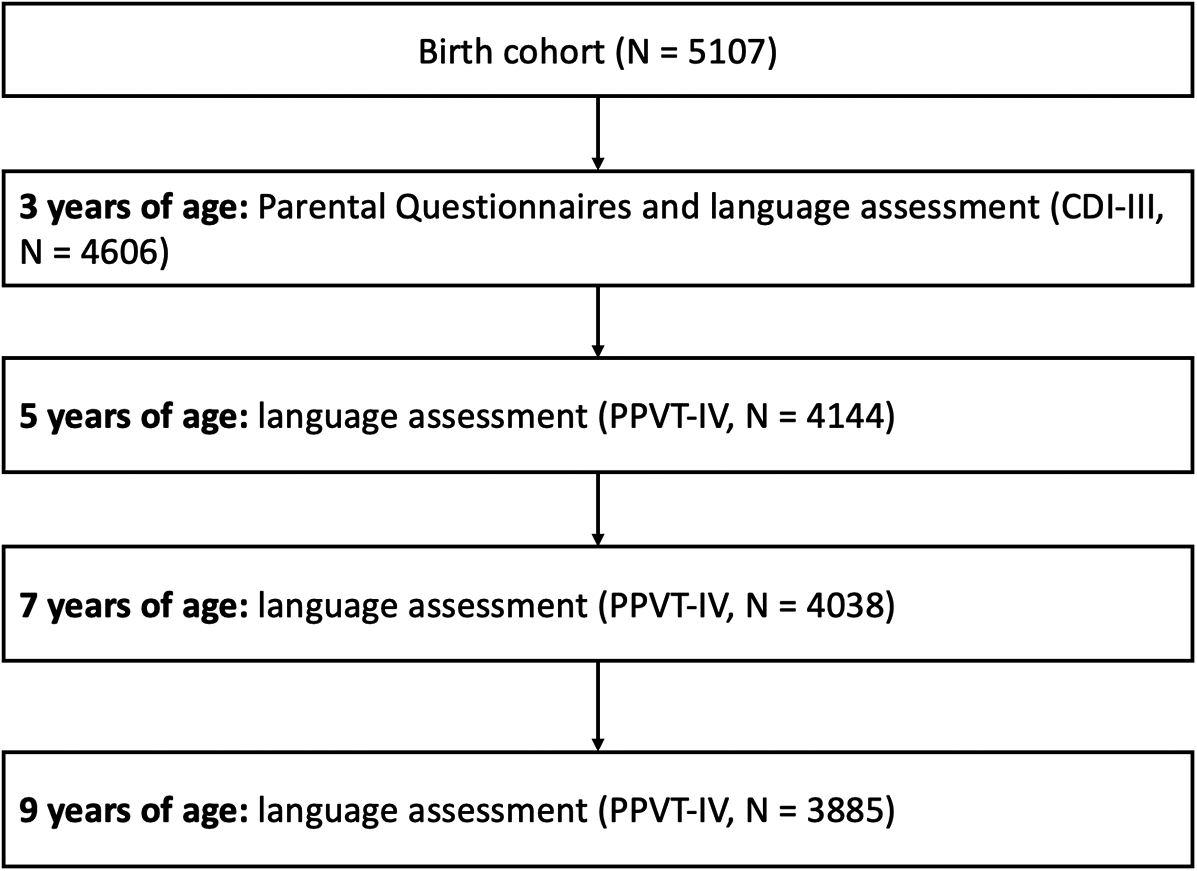
Figure 1. Flowchart depicting the study flow.
Table 1. The demographic characteristics of study participants (categorical variables are presented as percentage, and continuous variables are presented as a mean and standard deviation)

2.2. Measurements
Predictors. The predictors included: the measure of HLE that was obtained based on the Home Activities Questionnaire filled by primary caregivers. Primary caregivers were asked to fill in the questionnaire asking how frequently they engage in the following activities with a child: storytelling, drawing, music, toys/games, everyday activities, playing outdoors, and reading. The possible answers were: 0: None; 1: 1 or 2 days; 2: 3–5 days; and 3: Every day or 6–7 days per week. The composite score was calculated as the mean of responses for each activity and used as a measure of home language activities in the analysis.
Covariates. The covariates included: the child’s sex, gestational age (weeks), child’s age at testing (years), breastfeeding duration (in months), number of hours per week that the child spends in early childhood education and care, maternal education (6 categories: postgraduate, graduate, bachelor, advanced diploma, certificate, and other), paternal education (6 categories: postgraduate, graduate, bachelor, advanced diploma, certificate, and other), maternal age at delivery (years), maternal employment status (3 categories: employed, unemployed, and not in labour force), paternal employment status (3 categories: employed, unemployed, not in labour force), household income (continuous, AUD$ per week), household density (continuous, ratio of number of people in the household and number of bedrooms). These data were collected from questionnaires administered to the parents (see Table 1, for descriptive statistics, see Supplementary Material S1 for correlational analyses between covariates).
Outcomes. At 3 years of age, children’s language development was assessed by the parent-administered MacArthur-Bates Communicative Development Inventory, Level III (MCDI-III, Fenson et al., Reference Fenson, Marchman, Thal, Dale, Reznick and Bates2007), a vocabulary checklist for children from 30 to 37 months of age that measures expressive vocabulary and grammar. Two outcome measures were used: the MCDI-III expressive vocabulary score and the MCDI-III grammatical markers score. From 5 to 9 years of age, children’s receptive language skills were assessed by administering the Australian adaptation of Peabody Picture Vocabulary Test, 3rd Edition (PPVT-III, Dunn & Dunn, Reference Dunn and Dunn1997) at 5, 7, and 9 years of age (see Figure 1, for the study flow).
3. Results
3.1. Analysis 1: Association of HLE and concurrent language skills
To assess the relation of HLE at 3 years and concurrent language development, two linear models were fitted (one for CDI-III expressive vocabulary and one for CDI-III grammar measure). The models were fitted with CDI-III vocabulary/CDI-III grammar score as an outcome variable, the child’s HLE score as a predictor variable, and the above-mentioned covariates as control variables. The model fit was assessed by coefficients of determination R 2 and adjusted R 2 (Nakagawa & Schielzeth, Reference Nakagawa and Schielzeth2013). The children’s age was mean-centred by subtracting the average age from each participant’s age at testing, whereas all categorical variables were dummy-coded. Children with missing CDI-III scores were excluded from the analysis. The models were fitted using the lm function built in R (R Core Team, 2020). Regarding the predictor and control variables, missing data were not imputed, and the missing data percentage were following: home activities index (0%), childcare hours/week (30%), child’s sex (0%), gestational age (7%), age at testing (0%), breastfeeding duration (1%), maternal education (28%), paternal education (30%), maternal age at delivery (6%), maternal employment status (0%), paternal employment status (11%), household income (4%), and household density (0%).
The results demonstrated that a higher HLE score was related to a higher CDI-III expressive vocabulary score (β = 10.30, t = 8.75, [95% CIs: 7.99 to 12.61], p < 0.001) (see Table 2) and a higher CDI-III grammar score (β = 1.00, t = 5.18, [95% CIs: 0.62 to 1.38], p < 0.001) (see Table 3).
Table 2. Summary of a linear model fitted for the relation between HLE at 3 years of age and concurrent CDI-III expressive vocabulary score (significant p values are bolded)
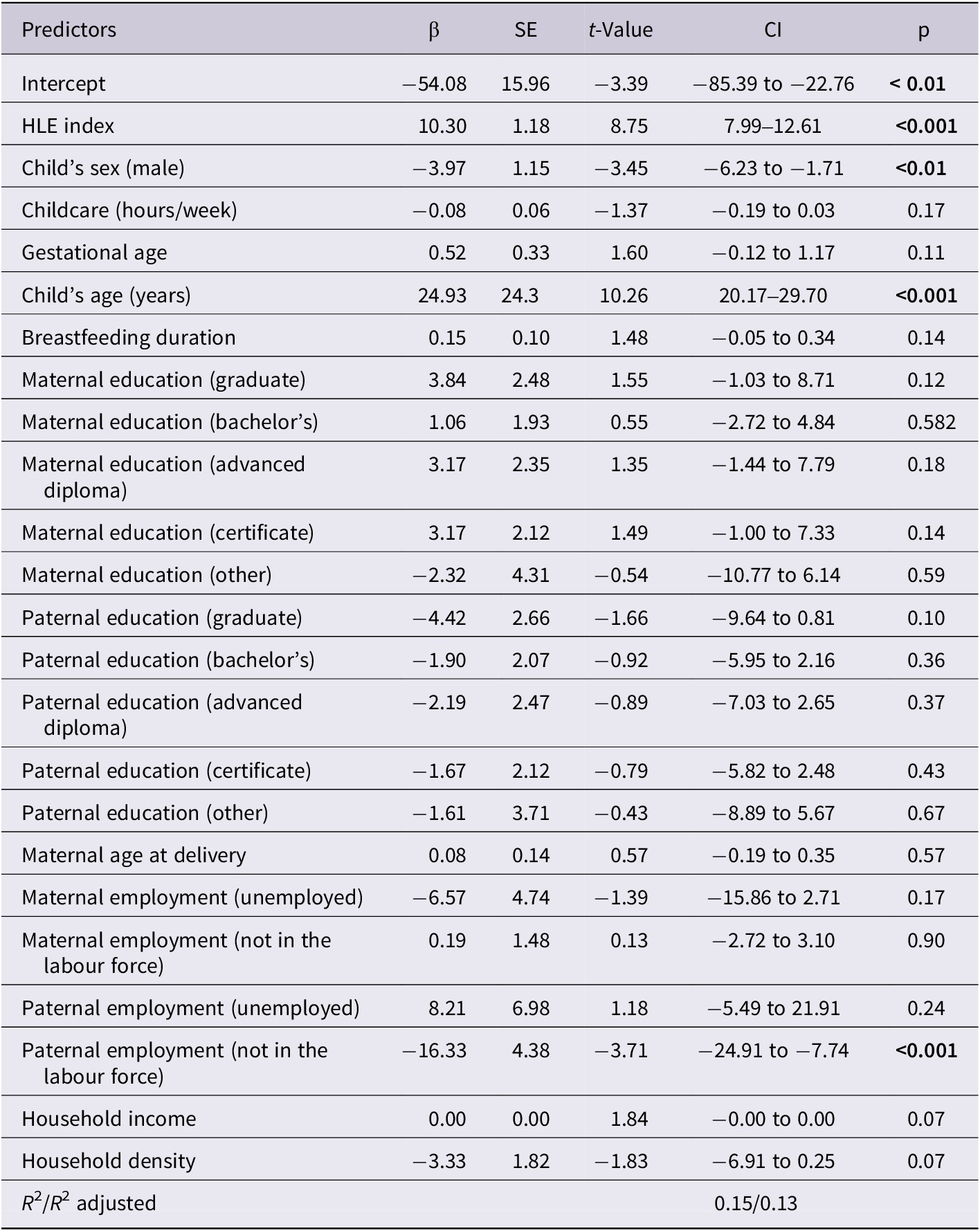
Table 3. Summary of a linear model fitted for the relation between HLE at 3 years of age and concurrent CDI-III grammar score (significant p values are bolded)
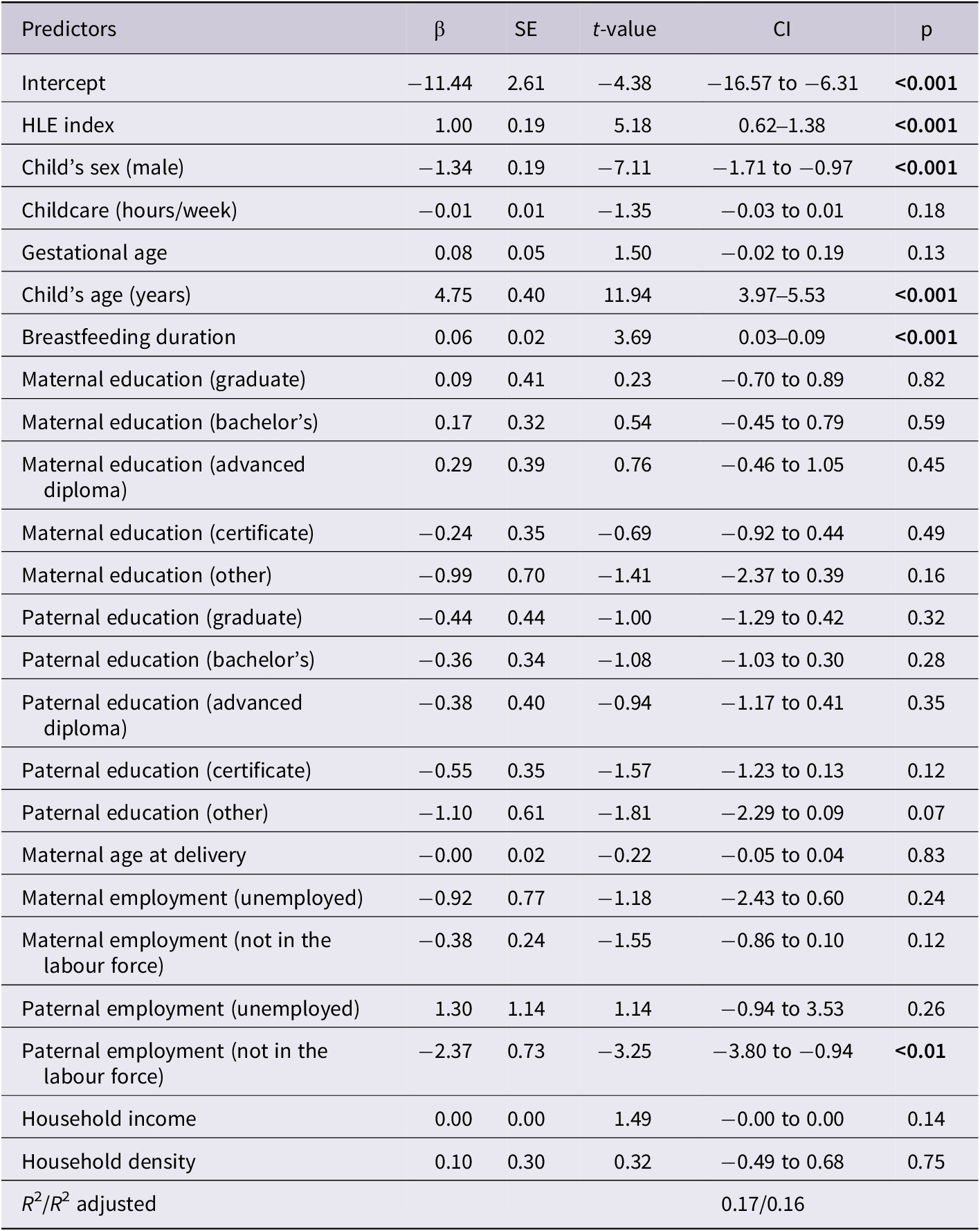
3.2. Analysis 2: Association of HLE and longitudinal language skills
As previously mentioned, children’s PPVT-III scores at 5, 7, and 9 years of age were used to assess vocabulary skills at school age. In the current sample, each child had between one and three PPVT observations; hence, a linear mixed-effects regression model was run as it allows the clustering of observations (e.g., due to repeated measures in a longitudinal design). Because in this dataset, the source of clustering was participants, the random intercept was specified for participants with an independent correlation structure. This specification allowed the model to classify the observations coming from the same participants, assigning to each participant its intercept. This controls for over-weighting due to multiple observations coming from the same participants in between-subject comparisons and provides that any within-subject variation is interpreted as a deviation from the participant’s baseline score. Hence, in the current analysis, PPVT observations per participant varied from one to three, and a specification of random intercept for participants controlled for participants contributing more than one PPVT score. To control for the difference in age of PPVT testing, the child’s exact age at testing was included in the model (together with the above-mentioned control variables). Thus, the association between HLE at 3 years and children’s longitudinal vocabulary skills was assessed via the linear mixed-effects model. The model with a restricted maximum likelihood estimation technique was fitted with children’s PPVT-III scores as an outcome variable, the HLE index at 3 years of age as a predictor, and the above-mentioned covariates as control variables. Children’s CDI-III expressive vocabulary and grammar scores were also added to the same model as covariates to control for children’s language skills at 3 years of age. The model fit was assessed by Nakagawa’s marginal and conditional coefficients of determination (R2, Nakagawa & Schielzeth, Reference Nakagawa and Schielzeth2013). The children’s age was mean-centred, whereas all categorical variables were dummy-coded. In cases where a child was missing language scores at all ages, the child was excluded from the analysis. Regarding the predictor and control variables, missing data were not imputed, and missing data percentage were following: home activities index (0%), childcare hours/week (30%), child’s sex (0%), birth weight (6%), gestational age (7%), age at testing (0%), body mass index (2%), breastfeeding duration (1%), maternal alcohol consumption during pregnancy (18%), maternal smoking status during pregnancy (18%), maternal postnatal depression (18%), maternal education (28%), paternal education (30%), maternal age at delivery (6%), paternal age at delivery (13%), maternal employment status (0%), paternal employment status (11%), household income (4%), household density (0%), CDI-III expressive vocabulary (25%), and CDI-III grammar (26%). The results showed that a higher HLE score at 3 years was related to a higher PPVT-III score between 5 and 9 years of age (β = 0.66, t = 3.66, [95% CIs: 0.31–1.01], p < 0.001, see Table 4).
Table 4. Summary of a linear-mixed effects model fitted for HLE at 3 years and longitudinal PPVT-III score (significant p values are bolded)
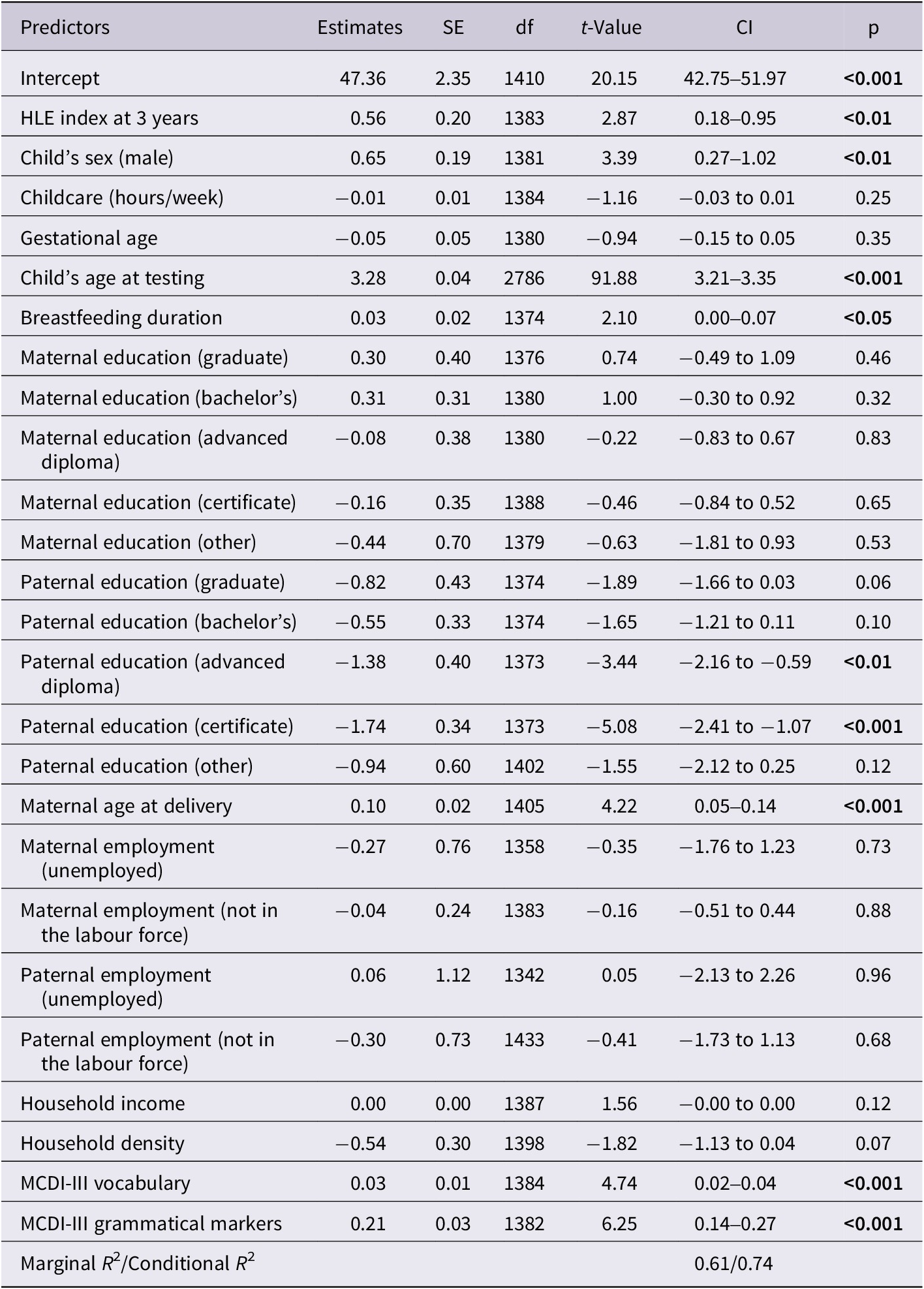
4. Discussion
The present study examined the relation between children’s HLE during toddlerhood (around 3 years of age) and concurrent and longitudinal language skills (from 5 to 9 years of age). The results demonstrated that a higher HLE was concurrently associated with greater language skills, specifically higher expressive vocabulary and grammar scores. Furthermore, the results showed a significant longitudinal relation between early HLE and receptive language skills from five to 9 years of age. The results suggest the benefits of early HLE operationalised as a frequency of participation in activities, such as storytelling, drawing, music, toys/games, everyday activities, playing outdoors, and reading for vocabulary development during preschool and school periods.
These findings broadly support the work of other studies in this area, linking children’s participation in home activities to their vocabulary skills. Additionally, given that the majority of previous studies showed the association of HLE with language skills up to 3 years of age, this study broadens these findings by indicating that this relation might persist beyond this age. Indeed, the results of this study showed that higher participation in HLE activities at 3 years of age is positively associated with children’s receptive language skills even during the early school period from 5 to 9 years of age. Although children of this age receive most of the input from school, it seems that early HLE still affects their receptive vocabulary growth. Furthermore, given that the majority of previous studies mostly assessed the relation between shared reading and language development, this study extends these findings to other aspects of HLE, such as drawing, storytelling, playing with toys, playing outdoors, and so forth. It is possible that these activities represent an opportunity for high-quality verbal caregiver-child interactions resulting in a diversity of topic and speech input (Roy et al., Reference Roy, Frank, DeCamp, Miller and Roy2015; Soderstrom & Wittebolle, Reference Soderstrom and Wittebolle2013; Tamis-LeMonda, Custode, et al., Reference Tamis-LeMonda, Custode, Kuchirko, Escobar and Lo2019b).
However, it should be noted that while the results indicate the positive associations between HLE and vocabulary development, they do not imply causation. Thus, it is possible that rich HLE does not cause better vocabulary skills in children, but that both have a common cause resulting in their correlation. Indeed, previous evidence suggests that when maternal linguistic ability is accounted for, HLE does not predict children’s literacy and language skills (Puglisi et al., Reference Puglisi, Hulme, Hamilton and Snowling2017). Similarly, our results demonstrated a significant correlation between maternal/paternal education and HLE index, with a higher education level resulting in higher HLE. It is possible that parents with a higher educational level also have higher language skills, providing richer speech input to children. Although the current study demonstrated the effects of HLE on vocabulary development while controlling for maternal and paternal education, the data on parental language skills were lacking. Additionally, results showed that maternal employment status also influenced HLE, with not being in the labour force resulting in lower HLE. However, since the cause of not being in the labour force is unknown, we will refrain from further interpretation of this result. Nevertheless, due to the correlational design of this study, we cannot answer the questions on whether a high HLE causes a higher vocabulary size or if there is a common cause of both.
Another finding of this study is that a higher HLE predicts higher CDI-III grammar scores. However, it is important to note that there was a low variability in children’s CDI-III grammar scores despite a large sample size, so caution is necessary when interpreting this finding.
This study has several strengths. First, this study employed a longitudinal design, which is beneficial to examine whether HLE toddlerhood might be related to language development during childhood. Additionally, the strength of this study is the use of a large sample from a longitudinal study of Australian children, that is a wider representation of children in terms of ethnicity and SES. Also, given that Australia is a Western society with rich ethnic diversity, our findings might be relevant to other Western societies. Finally, this study included a large sample size and controlled for a range of potential confounders related to children, parents, and households. Nonetheless, this study has several limitations. First, the frequency of home activities was measured via parental questionnaires, which might be prone to a response bias and less reliable than more objective observational measures (e.g., wearable cameras). Second, only children’s activities with their primary caregivers were assessed, which might not depict children’s overall HLE. Finally, the content of parental linguistic input during home activities might shed light on the specific quantity and quality of linguistic input during these activities that facilitate children’s language development.
5. Conclusion
In summary, these findings suggest the long-term benefits of a richer HLE for vocabulary development during childhood. Given that language skills are critical for cognitive, social, and emotional development with persisting effects into adulthood, this study advances our knowledge of adjusting components of toddlers’ early environment that might affect language acquisition. Hence, by demonstrating the benefits of HLE for language development up to 9 years of age, these findings support the findings on the role of children’s early environment as one of the foundations for successful learning and development later in life.
Supplementary material
The supplementary material for this article can be found at http://doi.org/10.1017/S0305000925100093.
Acknowledgements
This article uses unit record data from Growing Up in Australia: The Longitudinal Study of Australian Children, conducted by the Australian Government Department of Social Services (DSS). The findings and views reported in this article, however, are those of the author and should not be attributed to the Australian Government, DSS, or any of DSS’s contractors or partners. Doi: https://doi.org/10.26193/QR4L6Q.
Disclosure
No AI tools were used for writing of this article.
Funding statement
The author’s work is supported by the World Premier International Research Center Initiative (WPI), MEXT, Japan.
Competing interests
The author declares none.
